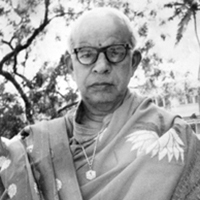An exploration into three fundamental but interrelated concepts in Indian philosophy: dharma (principle of sustenance), brahma (or brahman; Supreme spirit that pervades everything) and rasa (the aesthetic experience). While dharma is an efficient tool for managing life, rasa bridges the material and the spiritual, and brahma is the all-encompassing absolute.
The Sanskrit literary magazine Samskrita Pratibha from the Kendra Sahitya Academy has gained international reputation by its value-based contemporary writings in Sanskrit. The founder editor of this magazine, Dr. V. Raghavan, was not only a highly reputed scholar, but was also a Sanskrit poet. His multi-faceted expertise and scholarship brought him International fame. One of the memorable poems he wrote for Samskrita Pratibha, contains an important message of India’s contribution to the world. I quote:
धर्मो ब्रह्म रसो नाम
शिवं सत्यं च सुन्दरं |
या त्रिधा तत्वमूचे तां
संस्कृतप्रतिभां नुमः ||I bow to the glory of Sanskrit
that has taught
dharma, brahma, and rasa;
that is goodness, truth, and beauty.
One thing is appropriate to remember here. Though these appear to be similar to the concepts of Truth, Good and Beauty that the western world is acquainted with, there is a much broader and much deeper import, in general better and of higher value. This has already been explained, around 95 years ago, by Prof. M. Hiriyanna in his excellent essay “The Quest after Perfection.” Hence, our concepts of goodness (shivam), truth (satyam) and beauty (sundaram) are exceptional in their values as brahma, dharma, and rasa of our sanatana (eternal) tradition. Presently, let us examine the value and meaning of this triad to understand with clarity, the greatness of our tradition as well as the eternal principles that the world urgently needs.
Dharma
First let us examine the concept of dharma. As per the saying in the Mahabharata, धारणात् धर्म इत्याहुः धर्मो धारयति प्रजाः (dharanat dharma ityahuh dharmo dharayati prajah), dharma originates from the root "धृ-धारणे." It is a concept that sustains and enlivens everything and everyone. Sayana, the well-known commentator on the Vedas identifies this as the active / dynamic form of satya (truth). The ultimate principle in its existential form is satya. It is also the spoken form of the same. The order of truth of the universal consciousness is rta. The Vedas say it is the order that regulates the universe. In summary, rta is the cosmic order or universal system. Hence rta, satya, and dharma are very close. The Brihadaranyaka Upanishad says that dharma is an absolute good and that there is no higher principle in either the material or spiritual realms (BU 1.4.14). The Jaiminiya Purvamimamsa has termed dharma as the driving force of all action (JS 1.1.2). The Shabhara Bhashya says that dharma is the absolute good; it means that it is liked by all people.
What the Westerners (and those educated by them) term as 'religion' is unfortunately equated to the eternal principle of dharma. Definitely religion is not dharma. It is just a creed. This is not the right place for a discussion on religion or creed. However, the summary is this: Religion is based mainly on belief and faith, it is mostly personal and hence bound to a time and space with a variety of individual practices. Dharma is not like that. It is one. A non-qualified value system that applies to everyone as a samanyadharma. Self-confidence, forgiveness and tolerance, control over internal and external senses, freedom from greed, purity in thought and speech, non-violence, knowledge, wisdom, truth, and control over anger – are prescribed by the sage Manu in the Manusmrti (7.92) as the non-qualified and complete attributes of dharma. Further, he prescribes non-violence, truth, peace, purity of thought and speech and control over internal and external senses, as permanent values applicable to all humans (Manusmrti 10.63).
The values that are today touted by international organizations, human rights commissions, and the self-styled protector of the world, the US, are crystallized in a much broader and deeper manner by dharma that is in sync with the eternal Indian value system. Buddha, Christ, Basavanna, and Gandhi believed, followed and worked for this dharma. Among the two facets of dharma – samanya (common) and vishesha (special), the ancient Indian tradition may have, at times, emphasized more on the visible facet, the visheshadharma. Either by deliberate propaganda or by believing this as the underlying form, most people have forgotten and are making forget the glorious, noble, great common universal facet of dharma. Only when we realize this would wisdom reign.
Brahma
Let us now look into the concept of brahma. Coming from the root "बृहि - वृद्धौ," the word brahma indicates greatness, enormity and the highest. It is neither readable by description nor graspable by dry logic. It is only experiential. This is not a special sensory experience, but an attribute-less extra-sensory experience. Hence, this is neither to be newly acquired nor to be learnt from outside, but is the self-prevalent atma and the revealer of the ultimate, nay, the only Wisdom. Brahma is not attainable by human structures in the spacial and temporal frameworks such as genre, matter, attributes, activities, etc. It is our true abode and our original form. The nature of brahma is attribute-less-ness. It is the complete form of existence, consciousness and bliss. Hence the Upanishads call this as sacchidananda (sat-chit-ananda). Names and forms are just incidental, a mental construct. Since our true abode, the brilliance of the Self is brahma, the other external gods are just a reflection of the inner wisdom.
By a proper analysis of the avasthatrayas (the three states of consciousness – jagrata, 'waking;' svapna, 'dream;' sushupti, 'deep sleep'), by the Vedantic methodology of adhyaropa (superimposition) and apavada (negation), it is possible for anyone (irrespective of caste, creed, gender, nationality) to realize brahma. By the method of shravana–manana–nidhidhyasana (listening–understanding–being engrossed in), the experience of brahma is attainable. Other than this parabrahma there is nothing else. Everything else is just an illusion like the waves, bubbles, swirls, droplets, of a river.
The Buddhists called this shunya (nothingness), Virashaivas called it bayalu (emptiness), the yogis called it the philosophy of asamprajnata samadhi (non-qualified bliss), the philosophers of Tantra and Agamas called it the anuttara (ultimate). These are just many different words. The one who realizes this brahma becomes brahma and this is possible here and now – so proclaim the shastras. There is ample evidence in the form of those who attained this realization / liberation. The recurrence, from time to time, of the types of Vamadeva, Yajnavalkya, Buddha, Shankara, Abhinava, Allama, Ramakrishna, Ramana, and so on, provides a big evidence for the concept of Brahma. This is the universal path for the human race, unencumbered by religion, temples and maThas, higher and lower, oppression and suppression. The learning of adhyatma is nothing but the learning of brahma. This is the knowledge of all knowledge. It is the king of knowledge and wisdom. The Bhagavad-Gita calls it raja-guhyam (the crowning secret) (BG 9.2).
Rasa
Finally let us also look at the concept of rasa (art experience, aesthetic relish). Rasa, like brahma, is experiential, the essence of sat-chit-ananda (existence, consciousness, bliss). Hence this is called the younger brother of brahmananda (the bliss of brahma). In rasananda, even though there is no cessation of avidya (ignorance), since kama (desire) and karma (activity) cease, since it is subjective, it is a bit limited. It is said that the experience of art is rasa. This is the pleasurable preparation for the brahma experience, a beautiful process and platform for the upliftment of life. Dhvani (suggestion) is the path to rasa, aucitya (appropriateness) is the secret of rasa, saundarya (beauty) is its expression.
Conclusion
While dharma is an efficient tool for the optimal maturing in this life, rasa is the golden bridge between the material and the spiritual. Brahma, however, is the all encompassing absolute crystallized knowledge and wisdom.
All the three (dharma, brahma, rasa) are parts of the four purusharthas (the four-fold value system of human life). Dharma is well-known as the first purpose. Brahma is the heart of moksha (liberation), the final purpose. Since rasa is inherent in art, Vatsyayana and others classified it under the purpose kama (desire). The essence of Gandharvaveda is rasa. Since the core of this is kama, tradition has it that rasa is a synthesis of kama. As per the Gita, the Supreme dwells in living beings in the form of kama that is not contradicting dharma (BG 7.11). When we consider these, the appropriateness of reconciling kama and rasa is clear. The word kama comes from the root “कमु - कांत्यां." In the same way that kama, in its broad sense, pleases and makes the mind peaceful and self-contained, rasa too entails pleasure and peace. This is the opinion of the scholars of the shastras. All these are achieved by means of the second human value called artha (wealth, resources) (As platforms for achievement, dharma needs family, rasa needs art, and brahma needs the world).
Based on these three concepts all other social and cultural values have grown and shone. This is a very brief and non-comprehensive description.

















































